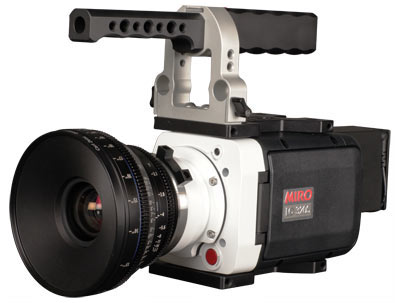WAYNE, N.J. (September 4, 2012) -- Vision Research, a leading manufacturer of digital high-speed imaging systems, has upgraded its popular Phantom® Miro line of cameras to become a more portable high-speed camera. This upgrade is designed to make high-speed imaging more accessible through ease of use and a smaller form factor.

The LC-Series cameras have a flip-out LCD touchscreen for on-camera control and monitoring. Camera settings can be changed with a few taps on the touchscreen, which doubles as a monitor for live preview and cine playback from internal memory. The LCD user interface is also available in multiple languages.
"The LCD screen was the most requested enhancement feature for the Miro M-Series cameras. We addressed this request with the introduction of the LC-Series. Vision Research continues to lead the high-speed digital imaging market with our innovation and response to customer feedback," says Rick Robinson, Division V.P. Marketing, Vision Research.
"While creating the LC-Series, portability and ease of use were the main priorities. The LC-Series cameras have the same sensitivity and high performance, for which the Miro line always has been recognized, with the added bonus of an LCD touch-screen."
The LC-Series is available in the same models as the Miro M-Series digital high-speed cameras: LC110, LC310, LC120 and LC320S. These flexible, easy-to-use cameras contain all the high-performance features that science, engineering and research professionals expect from Vision Research in a compact, simple design.
The 1-megapixel Miro LC110 and LC310 include a Vision Research custom-designed 1280x800 CMOS sensor, whose widescreen format that allows users to keep objects in the frame longer and see more of the event they are recording. The LC110 has a 1.6 Gigapixel/second (Gpx/s) throughput, making possible image capture up to 1600 frames-per-second (fps) at full resolution. The LC310 has a 3.2 Gpx/s throughput and can capture up to 3200 fps at full resolution. If higher speeds are needed, reduced resolution images are available up to 400,000 fps for the LC110 and 650,000 for the LC310. Both models feature high-light sensitivity and great dynamic range for superior low-light images, which are often a problem with high-speed imaging.
The 2-megapixel LC120 also includes a Vision Research custom-designed CMOS sensor with a 1.6 Gpx/s throughput, resulting in the capture of 730 fps at 1920x1200, 800 fps at 1920x1080, or 1200 fps at 1152x1152. If a higher speed is needed, the LC120 can deliver reduced resolution images up to 200,000 fps. The LC120 uses micro-lenses on its sensor to achieve high-light sensitivity and offers high-dynamic range for excellent image quality.
The LC320S is a breakthrough product for the entertainment and production market. It has 3.2 Gpx/s throughput that equals 1380 fps at 1920x1200 with higher frame rates at reduced resolutions. This camera has a 12-bit pixel depth and uses micro-lenses on its custom-designed CMOS sensor to achieve exceptional light sensitivity. It also includes a single HD-SDI port for alternate monitoring and workflow possibilities.
Key Features of the Phantom Miro LC-Series Cameras:
- Flip-out LCD touchscreen for on-camera control and monitoring
- 1 Megapixel and 2 Megapixel custom-designed CMOS sensors
- Up to 3.2 Gigapixels/second throughout
- High-light sensitivity
- Compact, rugged design
- Rechargeable battery
- Phantom CineFlash® storage system: 60GB, 120GB, and 240GB CineFlash, CineFlash Dock, eSATA Connectivity
Follow Vision Research on Twitter at @PhantomHiSpeed or friend them on Facebook, visionresearch and mirocameras.
About Vision Research
Vision Research is a leading manufacturer of high-speed digital imaging systems that are indispensable across a wide variety of applications including defense, automotive, engineering, science, medical research, industrial manufacturing, packaging, sports broadcast, TV production and digital cinematography. The Wayne, N.J.-based company designs and manufactures the most comprehensive range of digital high-speed cameras available today, all of which deliver unsurpassed light-sensitivity, image resolution, acquisition speed and image quality.
Over the course of its 60+ year history, Vision Research has earned numerous awards in recognition of its innovations in high-speed digital camera technology and sensor design, including a technical Emmy and an Academy AwardTM. Vision Research digital high-speed cameras add a new dimension to the sense of sight, allowing the user to see details of an event when it's too fast to see, and too important not toTM. For additional information regarding Vision Research, please visit www.visionresearch.com.
Vision Research is a business unit of the Materials Analysis Division of AMETEK Inc., a leading global manufacturer of electronic instruments and electromechanical devices.

















